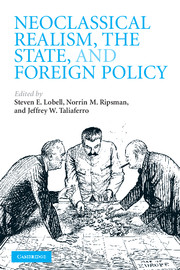Book contents
- Frontmatter
- Contents
- List of figures
- List of tables
- List of contributors
- Acknowledgments
- 1 Introduction: Neoclassical realism, the state, and foreign policy
- 2 Threat assessment, the state, and foreign policy: a neoclassical realist model
- 3 Neoclassical realism and strategic calculations: explaining divergent British, French, and Soviet strategies toward Germany between the world wars (1919–1939)
- 4 Neoclassical realism and identity: peril despite profit across the Taiwan Strait
- 5 Neoclassical realism and the national interest: presidents, domestic politics, and major military interventions
- 6 Neoclassical realism and domestic interest groups
- 7 Neoclassical realism and resource extraction: State building for future war
- 8 Neoclassical realism and state mobilization: expansionist ideology in the age of mass politics
- 9 The limits of neoclassical realism: additive and interactive approaches to explaining foreign policy preferences
- 10 Conclusion: The state of neoclassical realism
- Index
- References
5 - Neoclassical realism and the national interest: presidents, domestic politics, and major military interventions
Published online by Cambridge University Press: 05 June 2012
- Frontmatter
- Contents
- List of figures
- List of tables
- List of contributors
- Acknowledgments
- 1 Introduction: Neoclassical realism, the state, and foreign policy
- 2 Threat assessment, the state, and foreign policy: a neoclassical realist model
- 3 Neoclassical realism and strategic calculations: explaining divergent British, French, and Soviet strategies toward Germany between the world wars (1919–1939)
- 4 Neoclassical realism and identity: peril despite profit across the Taiwan Strait
- 5 Neoclassical realism and the national interest: presidents, domestic politics, and major military interventions
- 6 Neoclassical realism and domestic interest groups
- 7 Neoclassical realism and resource extraction: State building for future war
- 8 Neoclassical realism and state mobilization: expansionist ideology in the age of mass politics
- 9 The limits of neoclassical realism: additive and interactive approaches to explaining foreign policy preferences
- 10 Conclusion: The state of neoclassical realism
- Index
- References
Summary
Presidents of the United States have frequently decided to engage in military interventions abroad, but existing explanations of such intervention tend to emphasize either third-image (international) or second-image (domestic) factors. Third-image theories of intervention point to factors such as the international distribution of power and external threats. Second-image theories of intervention point to factors such as electoral incentives, together with the governing coalition's economic or political interests in war. However, as Jeffrey Taliaferro, Steven Lobell, and Norrin Ripsman argue in chapter 1, neoclassical realist theories generate more explanatory leverage over the national security behavior of states by incorporating both the domestic and international milieus. In this chapter I put forward a neoclassical realist model and show exactly how, why, and to what extent domestic politics matters in shaping US military interventions abroad. According to this model, when facing the possibility of major military intervention, presidents usually begin by consulting what they perceive to be the national security interests of the United States. Subsequently however, they consider how best to pursue those conceptions of the national interest in the light of domestic political incentives and constraints. These constraints frequently lead presidents to implement the precise conduct, framing, and timing of US intervention in a manner that may appear puzzling or anomalous from a neorealist perspective. In this sense, domestic politics “matters,” not as a primary cause of intervention, but rather as a powerful influence on its exact form.
- Type
- Chapter
- Information
- Neoclassical Realism, the State, and Foreign Policy , pp. 139 - 169Publisher: Cambridge University PressPrint publication year: 2009
References
- 29
- Cited by



